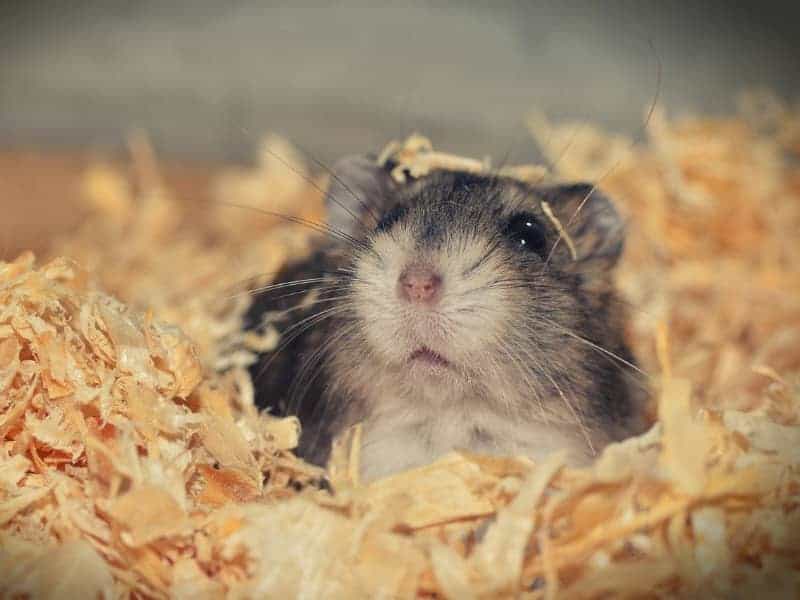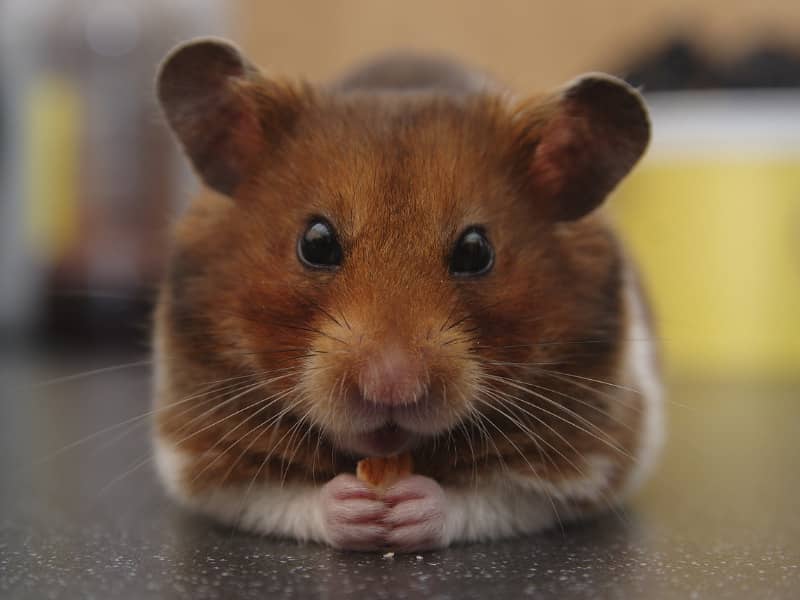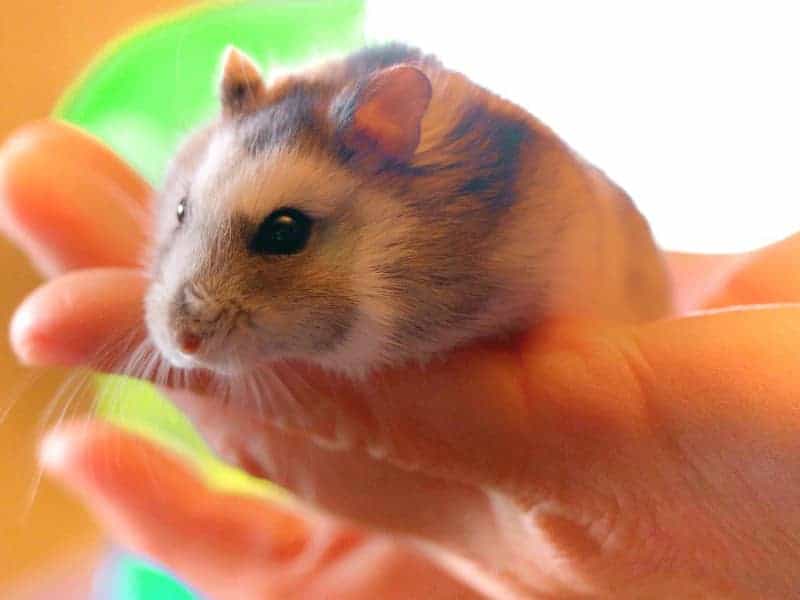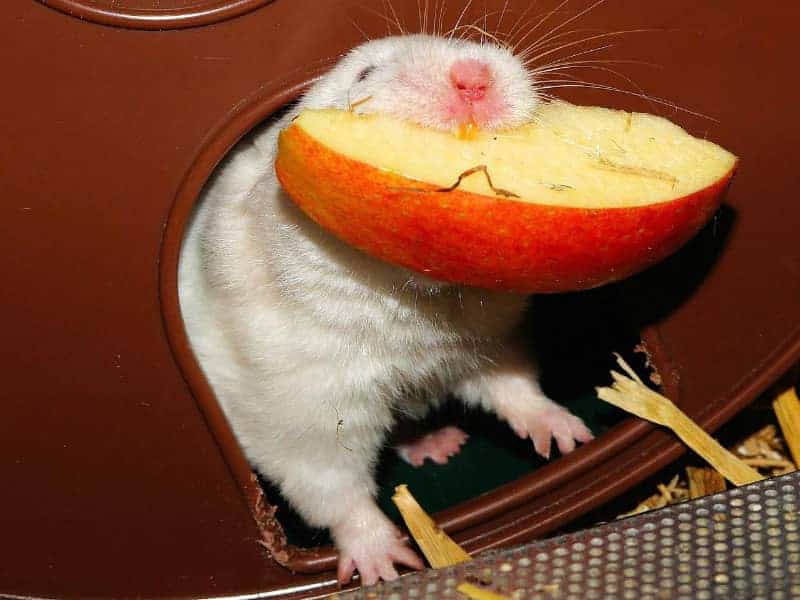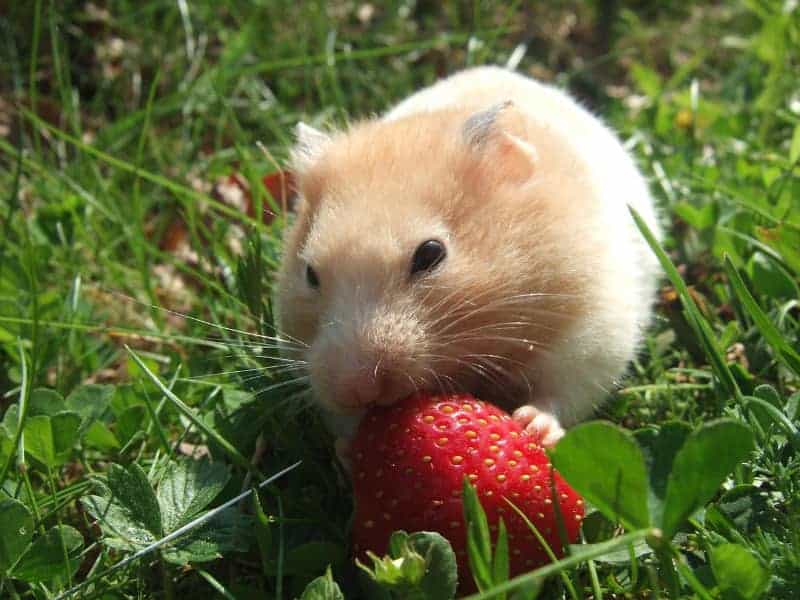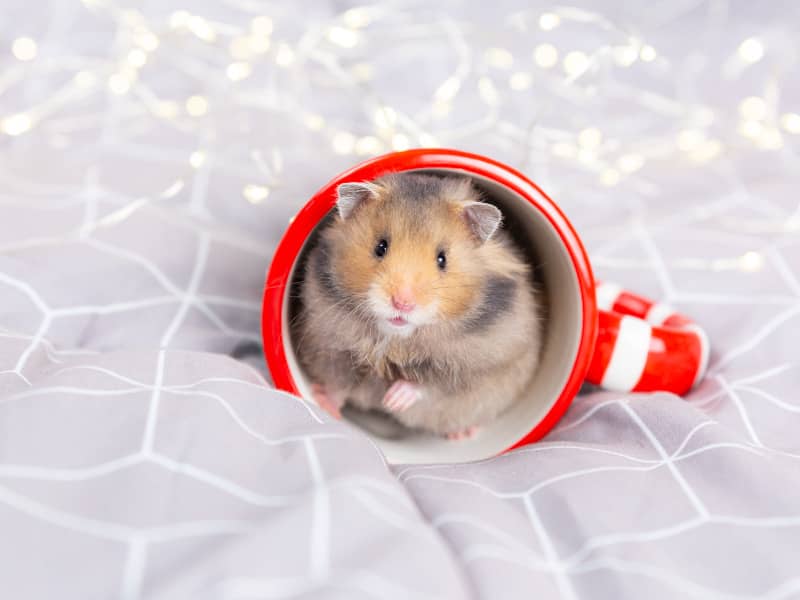
Hamster eye glued
A glued eye in your hamster is more than just a cosmetic problem. It can be a symptom of an underlying condition and should not be taken lightly. In this section, you'll learn what early signs and symptoms to look for, why it's important to act quickly, and how common this problem is.
Sticky eye - first signs and symptoms
A glued eye in a hamster is often the first visible sign of a health problem. It may be accompanied by other symptoms such as decreased activity, loss of appetite, or even breathing problems. A sticky eye can also be a sign of infection, which can quickly worsen if left untreated.
A glued eye is usually easy to spot. The hamster will try to rub his eye with his paws or it will just stay closed. Sometimes pus or some other type of discharge is also visible. It is important to recognize these signs early to allow for quick and effective treatment.
Why fast action is important
A sticky eye is not only uncomfortable for your hamster, but can also be a symptom of a serious condition. If you ignore the signs, you risk worsening your hamster's condition. In bad cases, this can lead to blindness or other serious health problems.
Fast action is therefore crucial. A visit to the veterinarian should be made as soon as possible to determine the exact cause and initiate appropriate treatment. Even if it is "only" a mild irritation, it is better to be on the safe side.
Frequency of the problem
Although a glued eye is not a constant occurrence in hamsters, it is not uncommon either. Many hamster owners will face this problem at least once during their hamster's lifetime. It is therefore important to be aware of this problem and know how to deal with it.
Frequency may also depend on the type of hamster and the conditions of its habitat. A clean, well-ventilated cage and a balanced diet can help minimize the risk of a stuck eye.
Possible causes of a glued eye in hamsters
A glued eye in your hamster can have several causes. In this section, we will go over the most common reasons that can lead to this condition. We look at infections, allergies, foreign bodies and trauma as possible triggers.
Infections
Infections are one of the most common causes of a stuck eye in hamsters. Bacteria or viruses can enter the eye and cause inflammation. The eye can become red, swollen and produce discharge that makes the eye sticky.
The infection can spread in several ways. It can occur through direct contact with an infected animal or through a dirty environment. In some cases, the infection can also be transmitted to the eye from other parts of the body, such as scratching or rubbing.
It is important to detect and treat an infection early. A veterinarian will usually perform a series of tests to identify the exact cause of the infection and initiate appropriate treatment.
Allergies
Allergies are another possible cause of a stuck eye in hamsters. Allergens such as dust, pollen or certain foods can trigger an allergic reaction that can lead to symptoms such as itching, redness and sticky eyes.
Treatment of allergy can be complicated, as it is often difficult to identify the exact allergen. However, a veterinarian can perform allergy testing and prescribe anti-allergic medications to relieve symptoms.
Foreign body
A foreign object in the eye is a less common, but still possible cause of a stuck eye. This could be a piece of litter, a grain of sand, or another small object that has gotten into the eye. A foreign body can cause irritation and inflammation that leads to a stuck eye.
In such cases, it is important to remove the foreign body as soon as possible to avoid further damage. A veterinarian can remove the foreign body under safe conditions and initiate further treatment measures.
Trauma
Trauma, such as a fall or a blow, can also lead to a stuck eye. In such cases, it is important to immediately present the hamster to a veterinarian to rule out internal injuries and initiate appropriate treatment.
Hamster eye stuck - first aid measures
If you notice that your hamster has a stuck eye, there are some first aid measures you can take. In this section, you'll learn how to gently clean the eye, why observing behavior is important, and when a visit to the vet becomes unavoidable.
Gentle cleaning of the eye
A sticky eye can be very uncomfortable for your hamster. One of the first things you can do is gently clean the eye. You can soak a soft cloth or a sterile compress with lukewarm water.
Carefully place the hamster on a flat surface and gently hold it. Then try to clean the eye with the damp cloth, wiping from the inner to the outer corner of the eye. Be as gentle as possible to avoid further irritation.
It is important that you use clean and sterile materials for this procedure to minimize the risk of infection. If you notice that the eye does not get better or even worsens after the cleaning, you should definitely consult a veterinarian.
Behavior observation
After cleaning, it is important to closely monitor your hamster's behavior. Watch to see if he continues to try to rub his eye or if he shows signs of discomfort, such as decreased activity or loss of appetite.
These observations can provide important clues for diagnosis and treatment by a veterinarian. If you notice that your hamster continues to show discomfort despite the first aid measures, it is advisable to consult a veterinarian as soon as possible.
When a visit to the vet is unavoidable
There are situations when a visit to the vet becomes inevitable. If the eye does not improve after cleaning and observation, if the hamster shows clear signs of discomfort or if the eye is very red and produces pus, you should not waste time and consult a vet.
A veterinarian can determine the exact cause of the stuck eye and initiate appropriate treatment. In some cases, more extensive tests such as blood tests or x-rays may also be necessary to identify the cause of the problem.
Here is a chart depicting different types of eye problems in hamsters, their symptoms, and recommended first aid measures:
| Type of eye problem | Symptoms | Recommended first aid measures |
| Sticky eye | Closed or half-closed eye, visible discharge | Gently clean with a damp, soft cloth; visit a veterinarian if there is no improvement. |
| Conjunctivitis | Redness, swelling, increased lacrimation | Vet visit for accurate diagnosis and treatment plan |
| Foreign body in the eye | Eye rubbing, tearing, possibly visible foreign body | Attempt to gently remove the foreign body with a damp cloth; visit veterinarian if unsuccessful. |
| Allergic reaction | Redness, itching, lacrimation | Removal of allergen, if possible; veterinary visit for allergy testing and medication. |
| Eye injury | Obvious injury, bleeding, swelling | Immediate visit to veterinarian; do not attempt self-treatment |
| Dry eye | Dull or cloudy appearance, apparent discomfort | Use of veterinarian recommended eye drops; veterinarian visit for accurate diagnosis. |
This chart is intended as a general guideline and is not a substitute for the advice of a qualified veterinarian. If your hamster shows signs of eye problems, it is always best to see a veterinarian as soon as possible.
Eye stuck - diagnosis and treatment by the veterinarian
If you find that your hamster has a gummed up eye and the first aid measures are not enough, the next step is to go to the vet. In this section, we will go over the different examination methods a veterinarian can use, talk about possible treatment approaches, and explain what medications and their use might be considered.
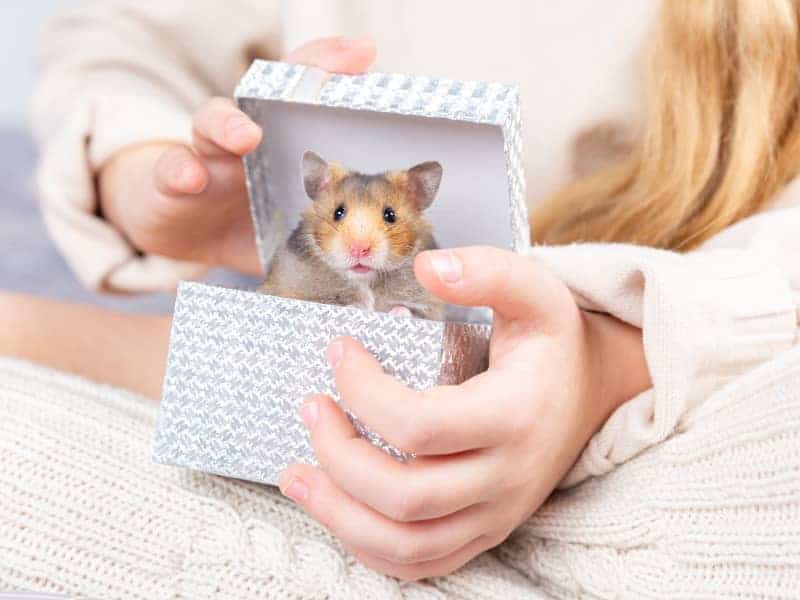
Research methods
The veterinarian will first perform a thorough examination of the eye. This often includes an inspection with a special lamp to look more closely at the structure of the eye. In some cases, a swab may also be taken to test for the presence of bacteria or other pathogens.
Other examination methods may include blood tests or x-rays, especially if it is suspected that the stuck eye is a symptom of an underlying condition. These tests will help the veterinarian make an accurate diagnosis and develop the best treatment plan for your hamster.
Possible treatment approaches
Depending on the diagnosis, treatment may vary. In the case of a bacterial infection, an antibiotic is often prescribed. In the case of an allergy, anti-allergic medications may be used. In cases where a foreign body irritates the eye, surgical removal may be necessary.
It is important to follow the veterinarian's instructions exactly and to carry out the treatment consistently. This is the only way to ensure that your hamster's eye heals completely and no permanent damage remains.
Drugs and their application
The type of medication the veterinarian prescribes depends on the exact diagnosis. It can be eye drops, ointments or even oral medication. The vet will give you precise instructions for use, which you should follow carefully.
It is important to use the medication as long as recommended by the veterinarian, even if the condition of the eye has already improved. Premature discontinuation of the medication may cause the problem to recur or even worsen.
Hamster eye glued - prevention and long-term care
A sticky eye in your hamster is not only unpleasant, but can also be a sign of serious health problems. Therefore, prevention is just as important as treatment. In this section, you'll learn how cage cleanliness, a balanced diet, and regular checkups and vet visits can help prevent it.
Cage cleanliness
A clean cage is the foundation of your hamster's health. Dirt and waste can harbor bacteria and other pathogens that can lead to a gummed up eye or other health problems. Therefore, it is important to clean the cage regularly.
Remove food remains and feces daily and replace the bedding at least once a week. A thorough cleaning of the entire cage should be done at least once a month. Also pay attention to corners and hiding places where dirt can accumulate.
Nutrition and health
A balanced diet is another important factor for your hamster's health. Malnutrition can weaken the immune system and make the hamster more susceptible to infections. Therefore, make sure that your hamster gets all the necessary nutrients.
Fresh fruits and vegetables can be a good addition to the main diet, but make sure everything is well washed to minimize the risk of contamination. A lack of vitamins and minerals can also lead to health problems such as a gummed up eye.
Regular checks and visits to the vet
Even with the best care, health problems can occur. Therefore, it is important to monitor your hamster regularly and watch for signs of illness. An annual check-up at the vet is also recommended to detect and treat potential problems early.
During these checkups, the veterinarian may also perform special eye exams to make sure everything is in order. These checkups can help minimize the risk of a stuck eye and other health problems.
FAQ: Hamster eye glued
In this section we answer some of the most frequently asked questions about "hamster eye glued". This FAQ should give you a quick overview of the most important points.
Can the problem solve itself?
In some cases, a slightly stuck eye can be resolved by simple first aid measures such as cleaning the eye. However, if there is no improvement after a few hours or the condition worsens, a visit to the veterinarian is unavoidable.
What are the costs of treatment?
The cost of treating a stuck eye can vary depending on what tests and medications are required. A simple visit to the vet can cost between €30 and €60, while special tests and medications can increase the cost.
How can I make it easier for my hamster to visit the vet?
A visit to the vet can be stressful for your hamster. To minimize stress, you can take a familiar blanket or small toy with you. Talk to your hamster during the trip and try to keep the transport cage as stable as possible.
How long does it take to heal a stuck eye?
The duration of healing depends on the cause and severity of the problem. For a mild irritation, the eye may recover within a few days, while a serious infection or injury may take several weeks to heal.
Are there any home remedies I can use?
While some home remedies such as chamomile tea are recommended for eye cleansing, it is always best to consult a veterinarian before you begin any form of self-treatment. Incorrect or improper treatment can make the problem worse.
Are other hamsters in the same cage at risk?
If the cause of the stuck eye is a contagious infection, there is a risk that other hamsters in the same cage may also be affected. In such cases, it is advisable to isolate the affected hamster and have all animals examined by a veterinarian.
How can I prevent recurrence?
The best prevention is maintaining a clean environment and a balanced diet for your hamster. Regular vet visits and health checks can also help prevent recurrence of the problem.
Author

-
Garden animal - A life with nature
Welcome to my animal blog! My name is Dirk and I am happy to take you on my journey through the fascinating world of animals and gardening.
Born 54 years ago, I have had an insatiable curiosity for the animal world around me since childhood. Although I have moved professionally in other industries, my true passion has always been animals and nature. It is remarkable how a small garden has become such an important part of my life.
Many of my fondest memories are associated with the animals that share our home. Whether it's the curious squirrels that scurry across the trees in the morning, the colorful variety of birds that visit our feeders, or the busy bees and butterflies that pollinate our flowers, every moment with them is invaluable to me.
This blog is my contribution to share my experiences, discoveries and insights with like-minded people. Here I will share stories of unforgettable encounters with animals, give tips on gardening and creating wildlife-friendly habitats, and take you on my journeys through nature.
Thank you so much for being here!
Cordial,
Dirk aka garden animal
Last posts
- 27. February 2024PetsVeganes Hundefutter – Grün und Gesund?
- 18. January 2024ChickensOregano für Hühner
- November 27, 2023HamsterDiurnal hamsters
- November 24, 2023HamsterHamster hammock

